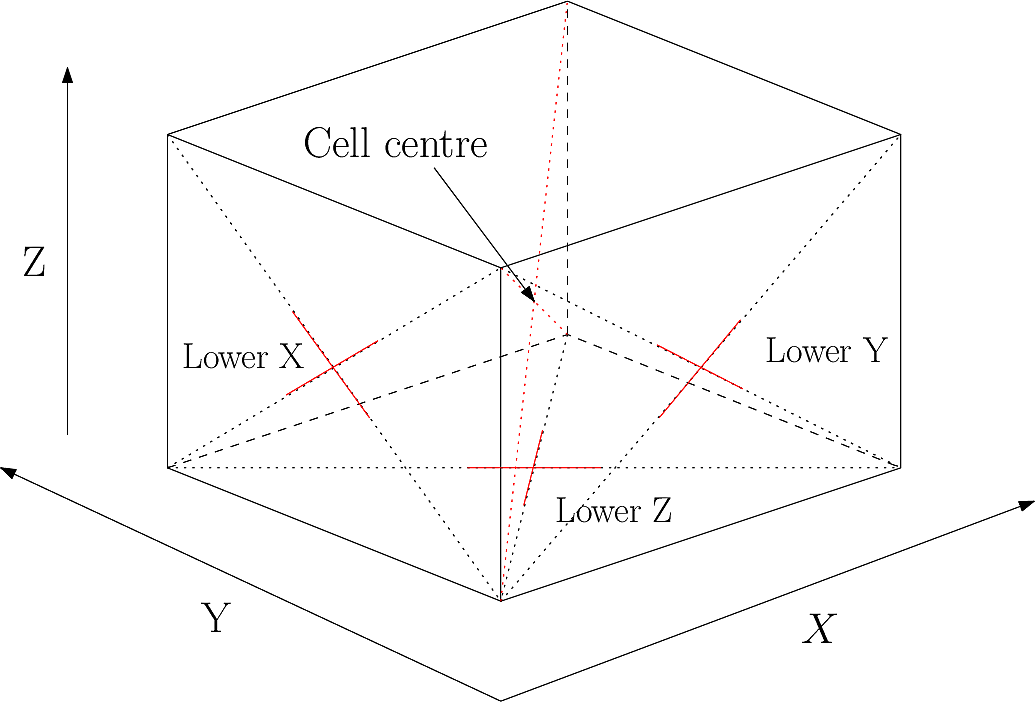Staggered grids#
Until now all quantities have been cell-centred i.e. both velocities and conserved quantities were defined at the same locations. This is because these methods are simple and this was the scheme used in the original BOUT. This class of methods can however be susceptible to grid-grid oscillations, and so most shock-capturing schemes involve densities and velocities (for example) which are not defined at the same location: their grids are staggered.
By default BOUT++ runs with all quantities at cell centre. To enable staggered grids, set:
StaggerGrids = true
in the top section of the BOUT.inp file. The test-staggered
example illustrates how to use staggered grids in BOUT++.
There are four possible locations in a grid cell where a quantity can be defined in BOUT++: centre, lower X, lower Y, and lower Z. These are illustrated in Fig. 18.

Fig. 18 The four possible cell locations for defining quantities#
To specify the location of a variable, use the method
Field3D::setLocation() with one of the CELL_LOC locations
CELL_CENTRE, CELL_XLOW, CELL_YLOW, or CELL_ZLOW.
The key lines in the staggered_grid example which specify the locations of the evolving variables are:
Field3D n, v;
int init(bool restart) {
v.setLocation(CELL_YLOW); // Staggered relative to n
SOLVE_FOR(n, v);
...
which makes the velocity v staggered to the lower side of the cell
in Y, whilst the density \(n\) remains cell centred.
Note
If BOUT++ was not configued with -DCHECK=0,
Field3D::setLocation() will throw an exception if you don’t
have staggered grids turned on and try to set the location
to something other than CELL_CENTRE. If you want to be
able to run your model with and without staggered grids, you
should do something like:
if (v.getMesh()->StaggerGrids) {
v.setLocation(CELL_YLOW);
}
Compiling BOUT++ with checks turned off will instead cause
Field3D::setLocation() to silently set the location to
CELL_CENTRE if staggered grids are off, regardless of what
you pass it.
Arithmetic operations can only be performed between variables with the same location. When performing a calculation at one location, to include a variable from a different location, use the interpolation routines. Include the header file
#include <interpolation.hxx>
then use the interp_to(field, location, region) function. For example,
given a CELL_CENTRE field n and a CELL_YLOW field v, to calculate
n*v at CELL_YLOW, call interp_to(n, CELL_YLOW)*v whose result will be
CELL_YLOW as n is interpolated.
Note
The region argument is optional but useful (see Iterating over fields
for more on regions). The default RGN_ALL reproduces the historical
behaviour of BOUT++, which communicates before returning the result
from interp_to. Communication is necessary because the result of
interpolation in the guard cells depends on data from another process
(except, currently, in the case of interpolation in the z-direction
which can be done without communication because all the z-points are
on the same process).
Using RGN_NOBNDRY no communication is performed (so interp_to is faster, potentially significantly faster when using many processes) and all the guard cells are invalid. Whichever region is used, the boundary guard cells are invalid since no boundary condition is applied in interp_to. If the guard cells are needed (e.g. to calculate a derivative) a boundary condition must be applied explicitly to the result.
RGN_NOX and RGN_NOY currently have identical behaviour to RGN_ALL because at present BOUT++ has no functions for single-direction communication which could in principle be used in these cases (if the combination of region and direction of interpolation allows it). x- or y-interpolation can never be calculated in guard cells without communication because the corner guard cells are never valid.
Differential operators by default return fields which are defined at
the same location as their inputs, so here Grad_par(v) would be
CELL_YLOW . If this is not what is wanted, give the location of the
result as an additional argument: Grad_par(v, CELL_CENTRE) uses
staggered differencing to produce a result which is defined at the
cell centres. It is an error to ask for the result to be staggered in
a different direction from the input as the best that could be done
would be to calculate output at CELL_CENTRE and then interpolate
this to the requested location, but the interpolation would in general
require boundary conditions to be applied first.
Advection operators which take two arguments return a result which is
defined at the location of the field being advected. For example
Vpar_Grad_par(v, f) calculates \(v \nabla_{||} f\) and returns a
result at the same location as f. If v and f are defined at
the same locations then centred differencing is used, if one is centred
and the other staggered then staggered differencing is used; it is an
error for both to be staggered to different locations. As with other
differential operators, the required location of the result can be
given as an optional argument, but at least for now it is an error for
this to be different from the location of the field being advected
(f here).
Laplace solvers (see Laplacian inversion) also need a location to be
set in order not to operate at CELL_CENTRE: this allows the solver
to check the locations of coefficients and right-hand-side which are
passed to it, and to return a result at the correct location. For
example, in an electromagnetic case with staggered grids, the solver
for the magnetic vector potential \(A_\|\) is probably defined on
the staggered grid. The location is set by the second optional
argument to Laplacian::create(), after the options. For example:
aparSolver = Laplacian::create(&options["apar_solver"], CELL_YLOW);